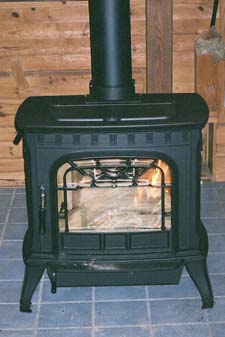Part 2 of 3

Temporary clothes dryer
Today I’m still worried, yet hopeful enough to stick with my subsistence activities and keep writing about my concerns. We don’t have running water on our homestead and do our laundry at a laundromat. This week I skipped using the gas drier and brought my wet clothes home to hang outside, even though it was raining. The weather radio had promised a dry, warmish day for Friday, the next day. My first activity Friday was to get the clothes hanging, but the weather turned out to be quite cold and very damp and felt like it could easily rain. I hung the small stuff inside near the woodstove and put my shirts and pants outside where it turned out they would not dry. Mid-afternoon I brought everything in the house where it did eventually dry, though things were congested around the stove. I’d probably have been better off with a more radical change – washing and drying a smaller amount of clothes entirely at home instead of washing a large amount all at once at the laundromat and assuming the weather was going to cooperate. Apparently Business Almost As Usual (BAAU) does not work so well even on a small scale.
BAAU (Business Almost As Usual) sustainability plans focus on changes in technology and efficiency without changing the root cause of environmental destruction and social inequity: globalized capitalist patriarchy. The BAAU approach to sustainability is so beneficial to powerful people in politics and business that no other possibilities for change are seriously discussed by government, the political class, or mainstream media. Decades of indoctrination against subsistence and rural living have made most of the populace in the developed world both completely dependent on society (e.g. food comes from grocery stores, not the earth) and scornful of rural life. Even environmental organizations like Worldwatch or Earth Policy Institute that are concerned with both environmental damage and social inequity propose BAAU plans to address poverty, global warming, habitat loss, and resource depletion, while failing to realize that their carefully crafted plans cannot and will not be carried out by a globalized, capitalist, patriarchal society whose very basis is oppression and theft from nature, women, and “developing” countries.
The leaders of the western world have been promising for decades that the “developing” world can “catch up” to the western “developed” world and many people in the West believe this promise. (See the book Ecofeminism by Maria Mies and Vandana Shiva.) This “catch up” view ignores the fact that “advancement” in the developed countries is made possible by taking the natural resources, lands, and work of the people in the “developing” world. Who will provide the unpaid for and unaccounted for resources to extend western style abundance to the developing countries?
We are now seeing the answer to this question as several of the large “developing” countries, including China, India, and Brazil, have begun to catch up. Elites and middle classes in developing countries like these are moving to a western lifestyle while people formerly living sustainable subsistence lifestyles are forced off the land and into expanding urban slums. At the same time the inability of our living planet to support the level of pollution (e.g. global warming) and resource depletion (e.g. food and water shortages, diminishing oil supplies) for billions more people living a “developed” lifestyle has become apparent. The earth cannot support a new coal-fired power plant coming on line every week in China on top of all the carbon burning already taking place in the “developed” world. Likewise the earth cannot support a meat-heavy diet expanded to billions more people since livestock produce massive quantities of greenhouse gases as they eat and digest the grain needed to feel billions of people.
The idea that billions of people can catch up and live a western “developed” lifestyle is clearly incorrect. But now that the ecological truths have been revealed, the BAAU plans for sustainability still pretend that with greater efficiency, use of renewable energy, and new technologies billions more people could live a modified, “developed”, yet sustainable, lifestyle, all without changing the social underpinnings of patriarchy, class, racism, and capitalism.
Most people living a “developed” lifestyle have (so far) little interest in returning to a subsistence way of life. On the other hand, people living a subsistence way of life do not voluntarily choose development, but are forced out of subsistence when their land and ability to live are taken by the powers of globalized, capitalist patriarchy (See Ecofeminism by Mies and Shiva). These are not parallel situations. Development is not the all desirable good that people in the developed world have been indoctrinated into believing. People living in developed countries are so dependent on society, that the idea of living through direct exchange with the earth is frightening. We lack the knowledge and skills of our ancestors. Our dependence on globalized capitalist patriarchy is no accident. Most of us have ancestors who were once the peoples forced off our lands for the benefit of patriarchal powers. Think of the enclosure movement in England, the Appalachian farmers forced off the land by the coal companies, the genocide of Native Americans by Europeans taking over the U.S. Dependence on globalized capitalist patriarchy keeps us participating and supporting this undesirable social structure.
There must be a way to wash my clothes without a washing machine!





